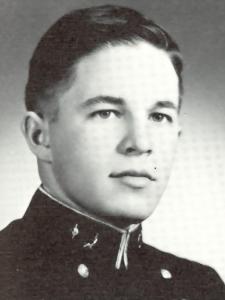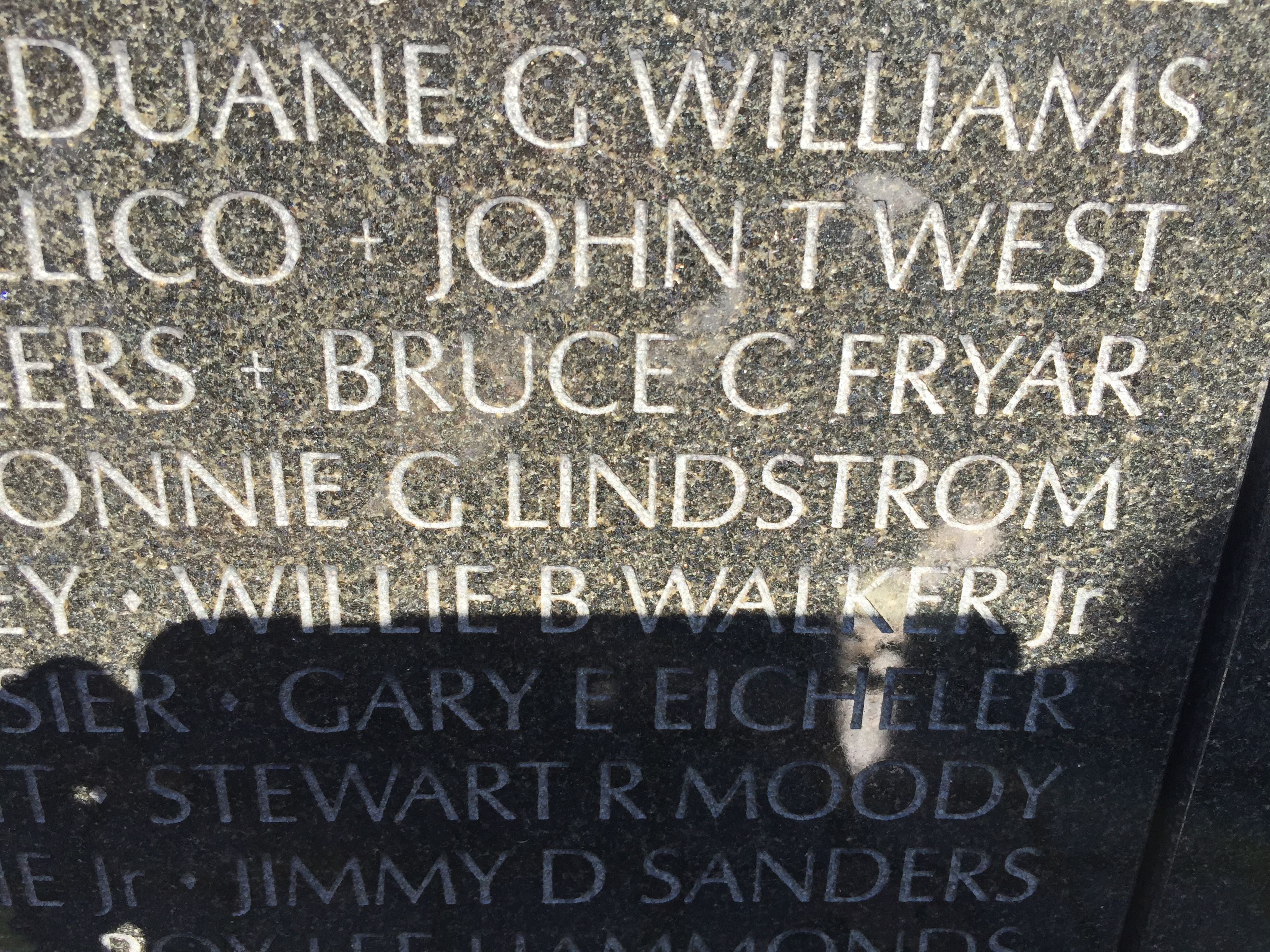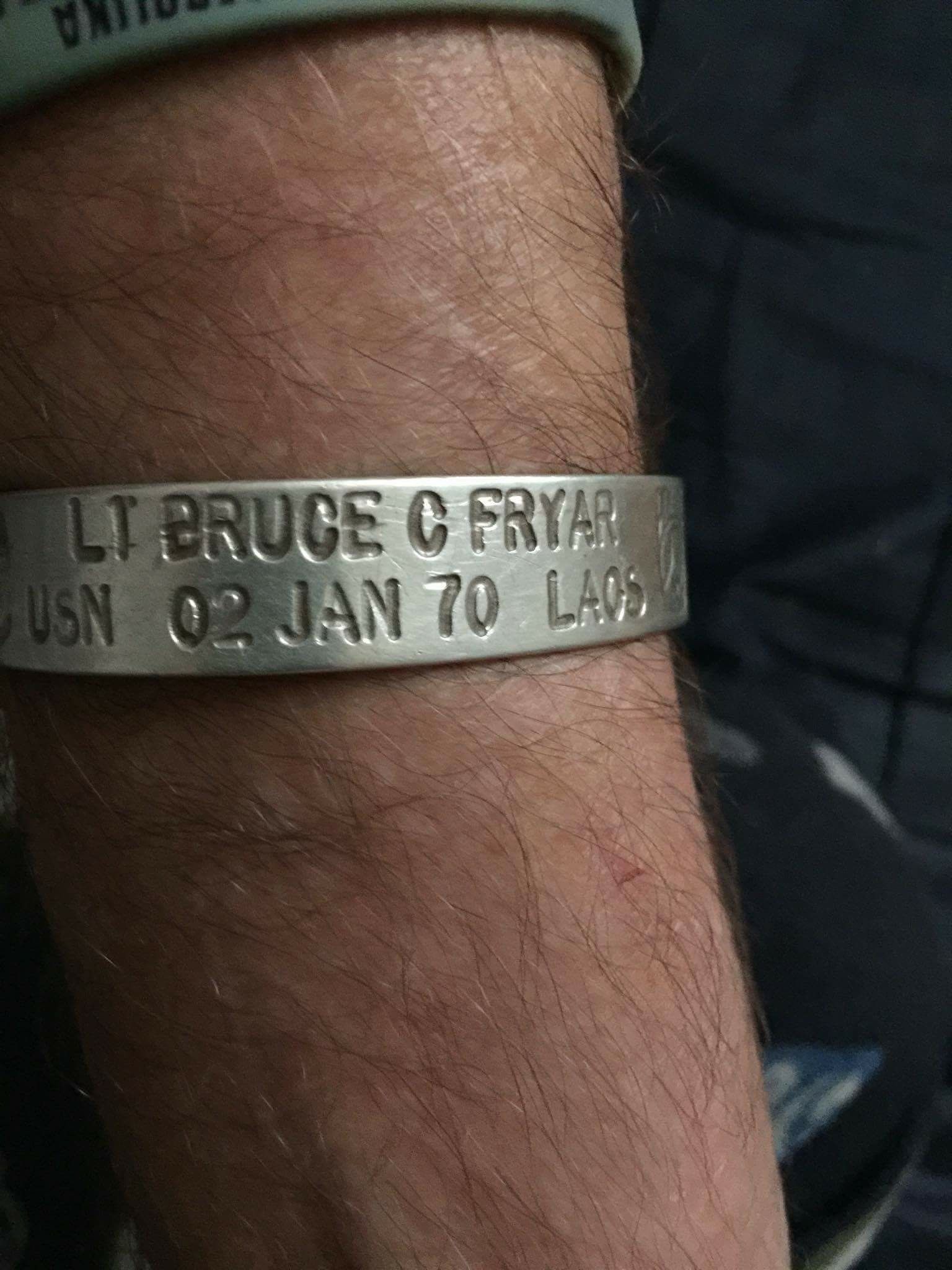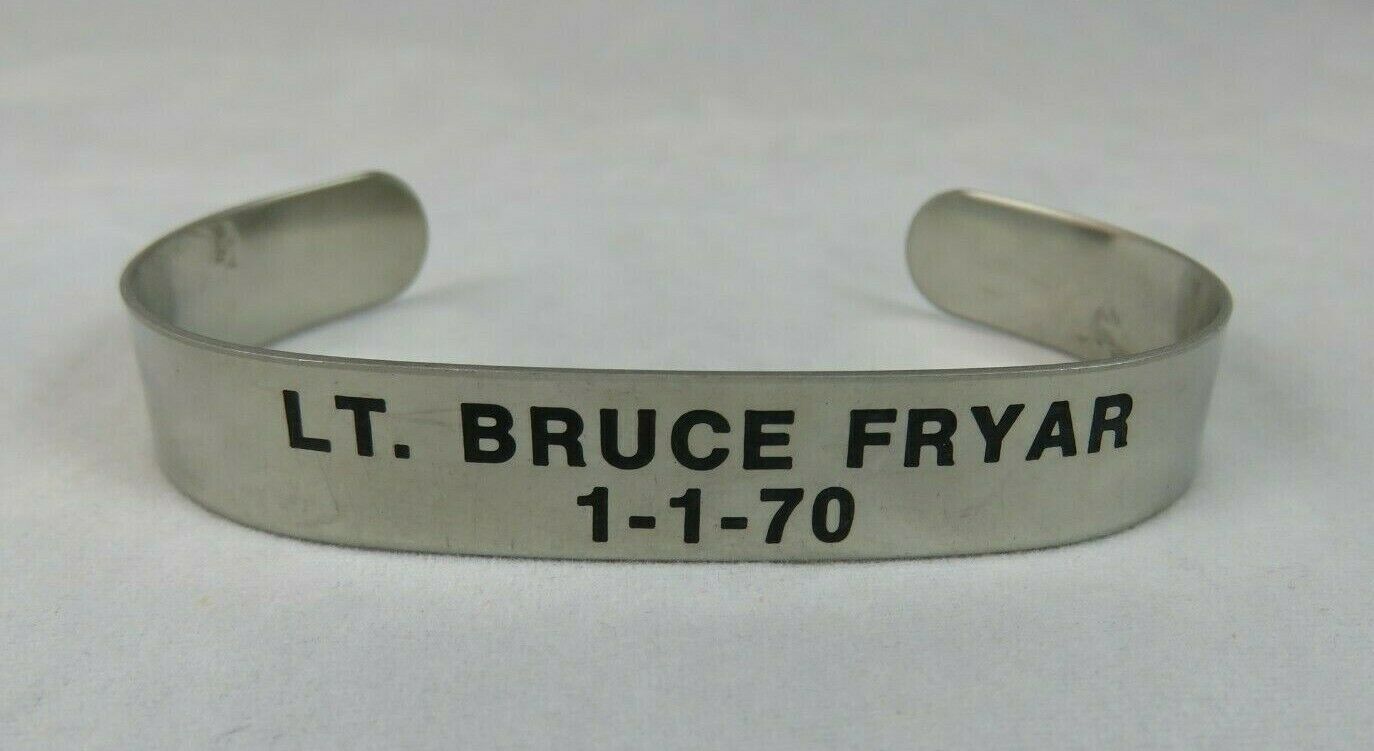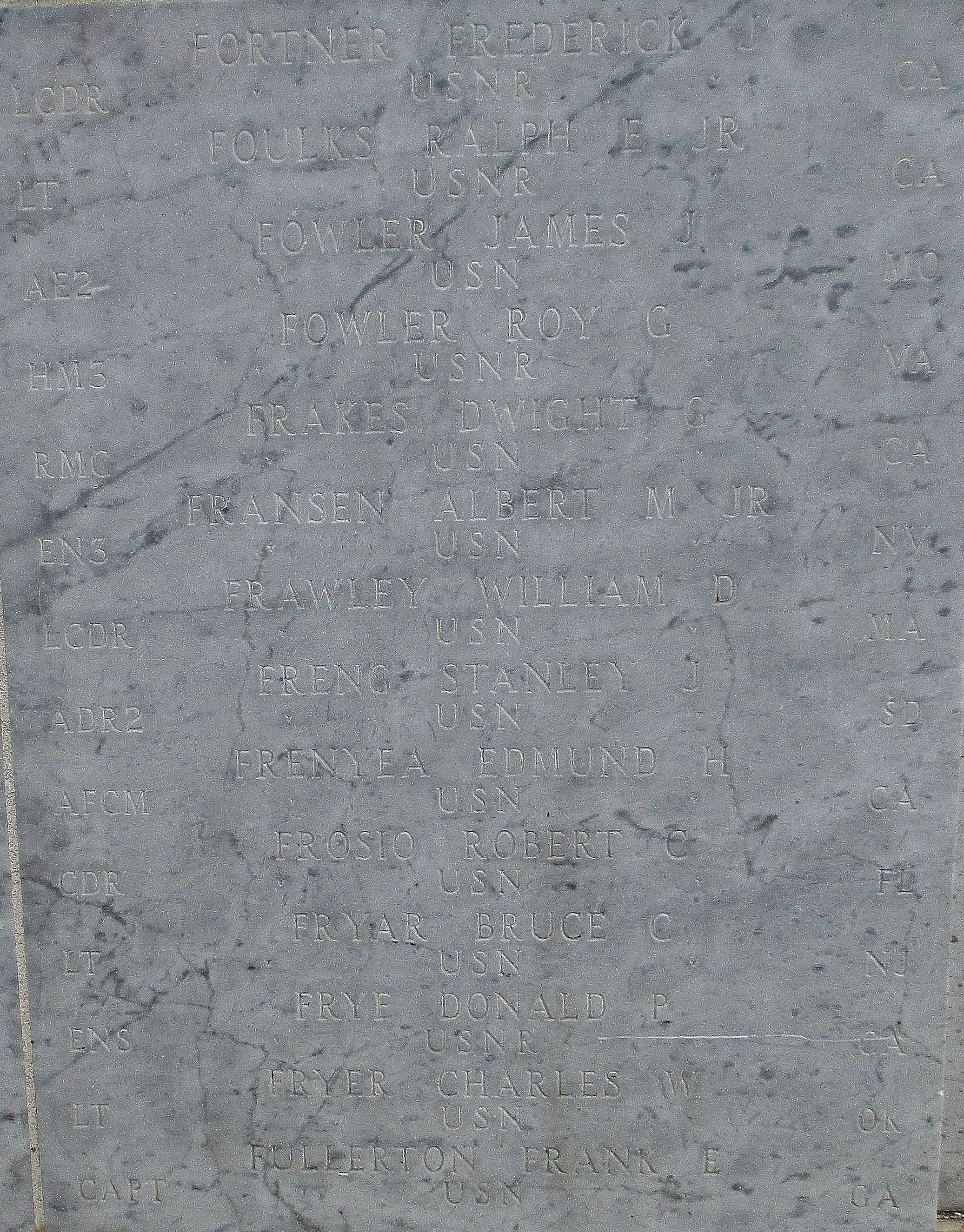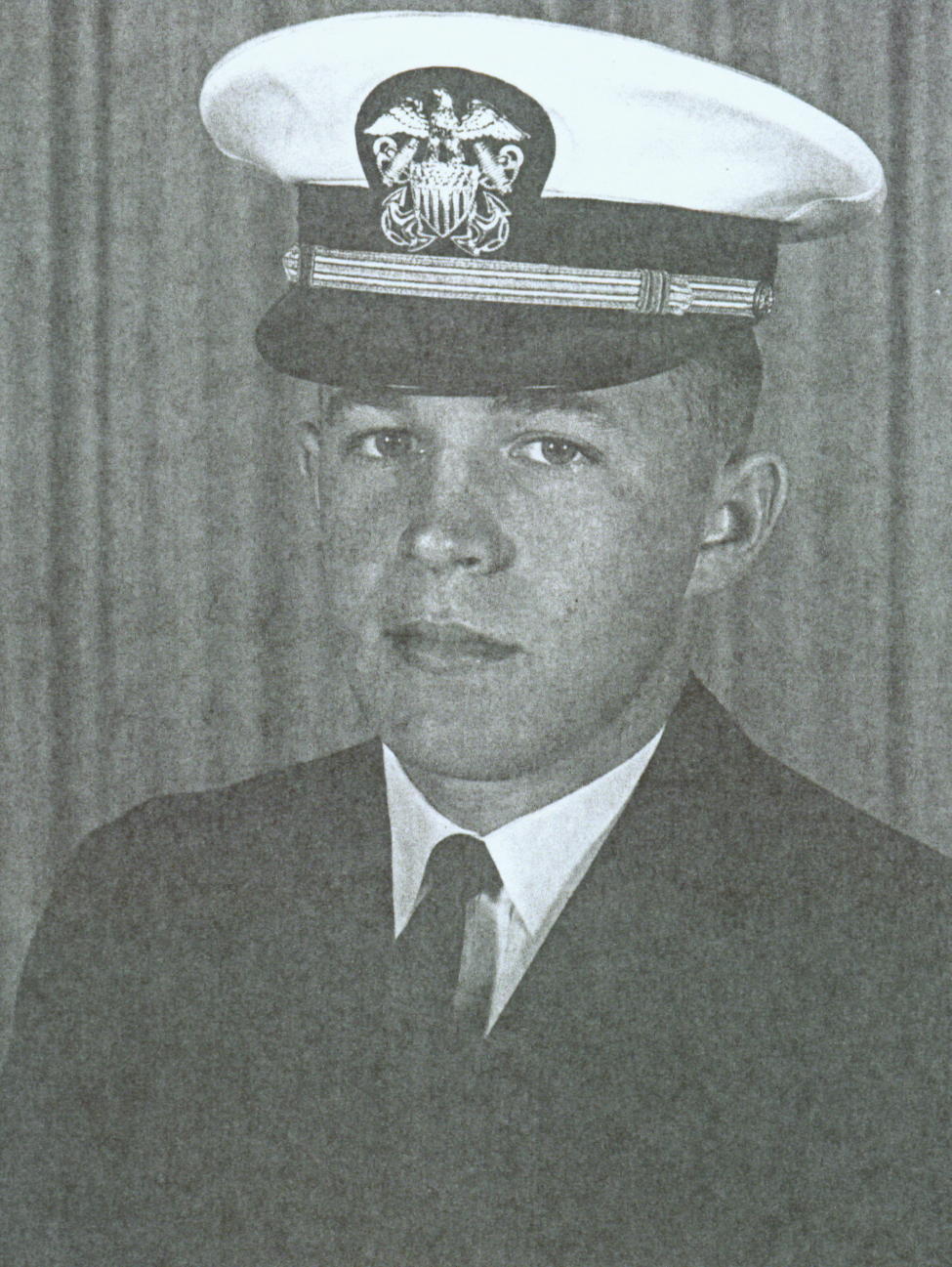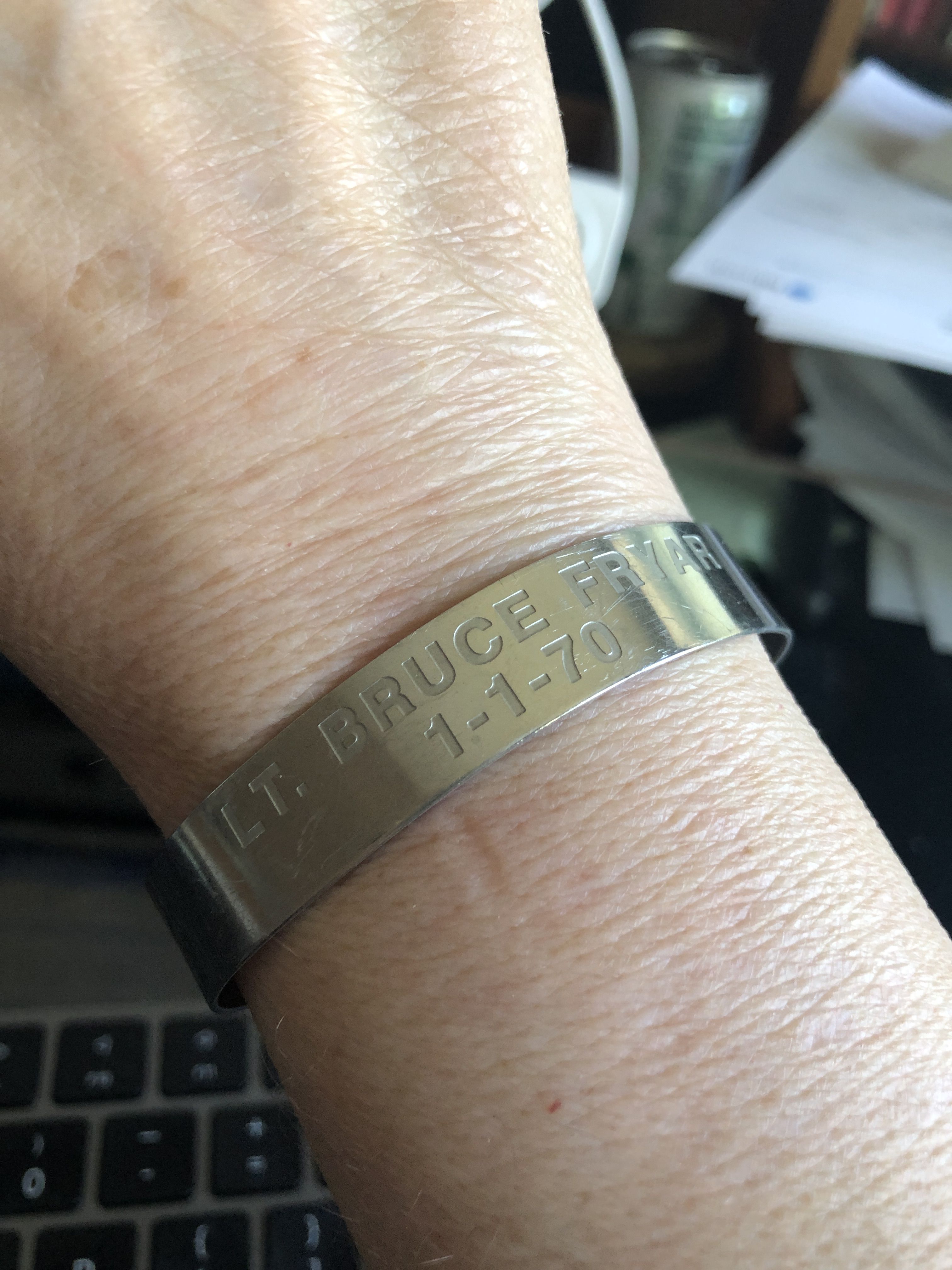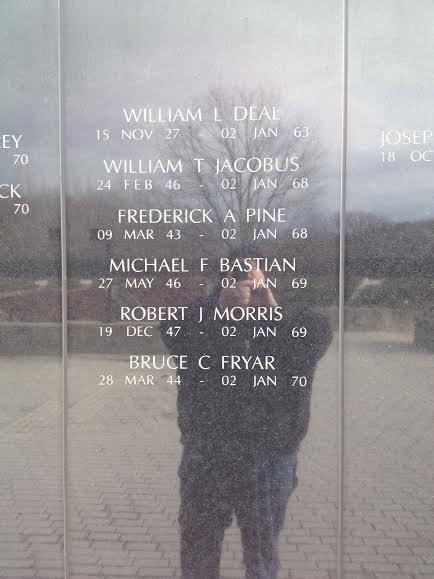On January 2, 1970, he was the pilot of a Grumman Attack Aircraft Intruder (A-6A) over Laos when during a dive bombing attack his aircraft was struck by enemy anti-aircraft fire, crashed and exploded.
His remains were never recovered.
His name is inscribed on the Courts of the Missing at the Honolulu Memorial.
Many thanks to contributor #48289027 for the following:
The final disposition of 23 of Ridgewood's 113 Honored Dead remains a mystery. They are missing in action. Of the hundreds of thousands of U.S. servicemen who went to Southeast Asia in the 1960s and 1970s, over 1,900 are still unaccounted for. Unlike veterans from previous wars, Vietnam veterans have made a concerted and very visible effort to locate their buddies who are POW/MIA. We see the black flag everywhere. On the other hand, the American Battle Monuments Commission, which is responsible for operating and maintaining permanent American military burial grounds in foreign countries for other 20th century conflicts, talks of MIAs as well as "Americans who gave their lives in the service of their country but whose remains were never recovered or identified" and co-mingles them on their "Tablets of the Missing". The result is that if you do a web search on "Missing in Action" you will find little relating to Korea, WWII or WWI but you will find hundreds of sites dedicated to MIAs from the Vietnam War. There are even "adopt-an-MIA" sites. One name frequently mentioned is Bruce Fryar of Ridgewood.
Although more than 700 MIAs have been identified since the shooting stopped in 1973, hundreds of families still have not received final news of their loved ones, including Carroll Fryar and his wife Belle who lived at 35 East Glen Ave. in Ridgewood from the late 1960s to the early 1970s while he was on assignment here as Manager for Continental Can Co. and their son Bruce was flying for Uncle Sam over Southeast Asia.
Bruce Fryar was born March 28, 1944 in Seattle, WA and grew up in Chicago. After graduation in 1962 from Proviso East High School in Maywood, Ill he attended the U.S. Naval Academy where his fine tenor voice gave him an important role in the Glee Club, which toured the country and appeared on the nationally televised Bell Telephone Hour, and the Chapel Choir. He also participated in intramural handball and lightweight football. An outstanding student and a Superintendent's List regular with a cumulative 3.2 GPA, he graduated in 1966 with a B.S. in Aeronautical Engineering.
After a month of primary flight training with Training Squadron 1 at Saufley Field Naval Auxiliary Air Station in Pensacola, he flew his first solo flight in a T34 "Mentor" trainer aircraft in early 1967. Then followed 13 months of advanced flight training before he received his "Wings of Gold". He reported to the Naval Air Station Whidbey Island, Oak Harbor, WA in early 1968 for training accompanied by his wife Diane and their infant daughter. Whidbey was the West Coast training and operations center for medium-attack bomber squadrons. He was granted "Top Secret" clearance and selected for the postgraduate education program, to be undertaken after his first sea tour. He missed the opportunity. Attack Squadron 196 (VA-196) became Whidbey's first squadron to receive the Grumman A-6A Intruder on Nov. 15, 1966. The A6 Intruder was considered to be the best ship-based attack aircraft.
He moved to Vietnam with VA-196 in late 1969 as part of Air Wing TWO on the USS Ranger, arriving at Yankee Station in November where they settled down to the daily routine of flights over the Ho Chi Minh Trail as the enemy moved anti-aircraft artillery into southern Laos. Bruce confided in a friend that he did not expect to survive the cruise; he nonetheless had the courage to pilot his A-6A every day in combat. VA-196 flew more A6 sorties and suffered greater losses than any other carrier-based squadron.
In 1969, as had become the custom, a 24-hour cease-fire was announced for the New Year's holiday. As had also become the custom, there were 111 enemy violations. On January 1, 1970 full-scale offensive operations resumed as 30 B52 bombers undertook raids in South Vietnam, near the Cambodian border. The next day, warplanes from the carrier USS Ranger again tried to close the Ho Chi Minh Trail.
That day, January 2, Lt. Fryar and his Bombardier/Navigator Lt. Nicholas G. Brooks, with a load of six MK82 bombs, were on a raid on a storage dump along the Ho Chi Minh Trail in the Mu Gia Pass area. At approximately 5,400 feet, on his second 40º dive during a visual dive-bombing attack, the plane exploded and the starboard wing separated from the fuselage, perhaps after being hit by 23mm flak. It is also possible that the bombs exploded prematurely. The plane crashed, exploded and burned. Other planes in the flight saw two parachutes and heard beeper signals from two survival radios, indicating that both crewmen had safely ejected.
Search and Rescue efforts began immediately. One man was sighted lying on the ground still wearing his parachute. A SAR helicopter crewman was lowered to attach a hoist to the man but heavy enemy ground fire forced the helicopter to take off before getting hold of the man. The SAR crewman was able to identify the flier as Lt. Fryar and indicated that he was dead.
The next day the SAR helicopter returned to find that the flier and the parachute were gone. An emergency beeper was heard but attempts to identify a pattern of transmission or voice contact were unsuccessful. After five days, SAR efforts were called off. Both crewmen were initially declared missing in action and eventually both were declared killed in action.
Captain Brooks' remains were identified and repatriated in April 1982. In February 1986 the Joint Casualty Resolution Center received information that remains had been recovered from this crash site but could not be identified as those of Lt. Fryar. In May 1991, a joint U.S./Lao investigation of a crash site believed to be Lt. Fryar's included an interview with witnesses who said the bodies of two crewmen were recovered after the incident and were buried in an adjacent bomb crater. The joint team recovered remnants of two survival tests, one flight suit and other artifacts but no remains. As no firm determination of his death has yet been made, he is listed as presumed dead, body not recovered – the official handle for MIA.
Bruce Fryar was awarded the Air Medal with Numeral "2" for "meritorious achievement in aerial flight… Lt. Fryar contributed materially to the success of the United States efforts in Southeast Asia. His skill, courage and devotion to duty in the face of enemy fire, under hazardous flying conditions, were in keeping with the highest traditions of the United States Naval Service". He was also awarded the Navy Commendation Medal with Combat "V", "for heroic achievement as a pilot of jet aircraft … during combat operations in Southeast Asia. On 22 December, 1969 Lt. Fryar was assigned the mission of destroying active enemy gun positions. He courageously piloted his aircraft within the lethal envelope of the antiaircraft artillery, purposely drawing fire to himself in order to pinpoint the weapons and execute the attack. A dive-bombing attack was made through an intense barrage of enemy fire, and his weapons were observed to detonate precisely on target. Lt. Fryar's actions significantly decreased the enemy threat to the other strike aircraft in the target area and allowed the primary target, enemy supplies, to be destroyed."
He also was awarded the Purple Heart, Combat Action Ribbon, Meritorious Unit Commendation, National Defense Service Medal, Vietnam Service Medal with one bronze star, Republic of Vietnam Meritorious Unit Citation (Gallantry Cross Medal Color with Palm) and the Republic of Vietnam Campaign Medal, all posthumously. When lost, Bruce Fryar was 26 years old.
On January 2, 1970, he was the pilot of a Grumman Attack Aircraft Intruder (A-6A) over Laos when during a dive bombing attack his aircraft was struck by enemy anti-aircraft fire, crashed and exploded.
His remains were never recovered.
His name is inscribed on the Courts of the Missing at the Honolulu Memorial.
Many thanks to contributor #48289027 for the following:
The final disposition of 23 of Ridgewood's 113 Honored Dead remains a mystery. They are missing in action. Of the hundreds of thousands of U.S. servicemen who went to Southeast Asia in the 1960s and 1970s, over 1,900 are still unaccounted for. Unlike veterans from previous wars, Vietnam veterans have made a concerted and very visible effort to locate their buddies who are POW/MIA. We see the black flag everywhere. On the other hand, the American Battle Monuments Commission, which is responsible for operating and maintaining permanent American military burial grounds in foreign countries for other 20th century conflicts, talks of MIAs as well as "Americans who gave their lives in the service of their country but whose remains were never recovered or identified" and co-mingles them on their "Tablets of the Missing". The result is that if you do a web search on "Missing in Action" you will find little relating to Korea, WWII or WWI but you will find hundreds of sites dedicated to MIAs from the Vietnam War. There are even "adopt-an-MIA" sites. One name frequently mentioned is Bruce Fryar of Ridgewood.
Although more than 700 MIAs have been identified since the shooting stopped in 1973, hundreds of families still have not received final news of their loved ones, including Carroll Fryar and his wife Belle who lived at 35 East Glen Ave. in Ridgewood from the late 1960s to the early 1970s while he was on assignment here as Manager for Continental Can Co. and their son Bruce was flying for Uncle Sam over Southeast Asia.
Bruce Fryar was born March 28, 1944 in Seattle, WA and grew up in Chicago. After graduation in 1962 from Proviso East High School in Maywood, Ill he attended the U.S. Naval Academy where his fine tenor voice gave him an important role in the Glee Club, which toured the country and appeared on the nationally televised Bell Telephone Hour, and the Chapel Choir. He also participated in intramural handball and lightweight football. An outstanding student and a Superintendent's List regular with a cumulative 3.2 GPA, he graduated in 1966 with a B.S. in Aeronautical Engineering.
After a month of primary flight training with Training Squadron 1 at Saufley Field Naval Auxiliary Air Station in Pensacola, he flew his first solo flight in a T34 "Mentor" trainer aircraft in early 1967. Then followed 13 months of advanced flight training before he received his "Wings of Gold". He reported to the Naval Air Station Whidbey Island, Oak Harbor, WA in early 1968 for training accompanied by his wife Diane and their infant daughter. Whidbey was the West Coast training and operations center for medium-attack bomber squadrons. He was granted "Top Secret" clearance and selected for the postgraduate education program, to be undertaken after his first sea tour. He missed the opportunity. Attack Squadron 196 (VA-196) became Whidbey's first squadron to receive the Grumman A-6A Intruder on Nov. 15, 1966. The A6 Intruder was considered to be the best ship-based attack aircraft.
He moved to Vietnam with VA-196 in late 1969 as part of Air Wing TWO on the USS Ranger, arriving at Yankee Station in November where they settled down to the daily routine of flights over the Ho Chi Minh Trail as the enemy moved anti-aircraft artillery into southern Laos. Bruce confided in a friend that he did not expect to survive the cruise; he nonetheless had the courage to pilot his A-6A every day in combat. VA-196 flew more A6 sorties and suffered greater losses than any other carrier-based squadron.
In 1969, as had become the custom, a 24-hour cease-fire was announced for the New Year's holiday. As had also become the custom, there were 111 enemy violations. On January 1, 1970 full-scale offensive operations resumed as 30 B52 bombers undertook raids in South Vietnam, near the Cambodian border. The next day, warplanes from the carrier USS Ranger again tried to close the Ho Chi Minh Trail.
That day, January 2, Lt. Fryar and his Bombardier/Navigator Lt. Nicholas G. Brooks, with a load of six MK82 bombs, were on a raid on a storage dump along the Ho Chi Minh Trail in the Mu Gia Pass area. At approximately 5,400 feet, on his second 40º dive during a visual dive-bombing attack, the plane exploded and the starboard wing separated from the fuselage, perhaps after being hit by 23mm flak. It is also possible that the bombs exploded prematurely. The plane crashed, exploded and burned. Other planes in the flight saw two parachutes and heard beeper signals from two survival radios, indicating that both crewmen had safely ejected.
Search and Rescue efforts began immediately. One man was sighted lying on the ground still wearing his parachute. A SAR helicopter crewman was lowered to attach a hoist to the man but heavy enemy ground fire forced the helicopter to take off before getting hold of the man. The SAR crewman was able to identify the flier as Lt. Fryar and indicated that he was dead.
The next day the SAR helicopter returned to find that the flier and the parachute were gone. An emergency beeper was heard but attempts to identify a pattern of transmission or voice contact were unsuccessful. After five days, SAR efforts were called off. Both crewmen were initially declared missing in action and eventually both were declared killed in action.
Captain Brooks' remains were identified and repatriated in April 1982. In February 1986 the Joint Casualty Resolution Center received information that remains had been recovered from this crash site but could not be identified as those of Lt. Fryar. In May 1991, a joint U.S./Lao investigation of a crash site believed to be Lt. Fryar's included an interview with witnesses who said the bodies of two crewmen were recovered after the incident and were buried in an adjacent bomb crater. The joint team recovered remnants of two survival tests, one flight suit and other artifacts but no remains. As no firm determination of his death has yet been made, he is listed as presumed dead, body not recovered – the official handle for MIA.
Bruce Fryar was awarded the Air Medal with Numeral "2" for "meritorious achievement in aerial flight… Lt. Fryar contributed materially to the success of the United States efforts in Southeast Asia. His skill, courage and devotion to duty in the face of enemy fire, under hazardous flying conditions, were in keeping with the highest traditions of the United States Naval Service". He was also awarded the Navy Commendation Medal with Combat "V", "for heroic achievement as a pilot of jet aircraft … during combat operations in Southeast Asia. On 22 December, 1969 Lt. Fryar was assigned the mission of destroying active enemy gun positions. He courageously piloted his aircraft within the lethal envelope of the antiaircraft artillery, purposely drawing fire to himself in order to pinpoint the weapons and execute the attack. A dive-bombing attack was made through an intense barrage of enemy fire, and his weapons were observed to detonate precisely on target. Lt. Fryar's actions significantly decreased the enemy threat to the other strike aircraft in the target area and allowed the primary target, enemy supplies, to be destroyed."
He also was awarded the Purple Heart, Combat Action Ribbon, Meritorious Unit Commendation, National Defense Service Medal, Vietnam Service Medal with one bronze star, Republic of Vietnam Meritorious Unit Citation (Gallantry Cross Medal Color with Palm) and the Republic of Vietnam Campaign Medal, all posthumously. When lost, Bruce Fryar was 26 years old.
Gravesite Details
cenotaph
Sponsored by Ancestry
Advertisement
Advertisement
